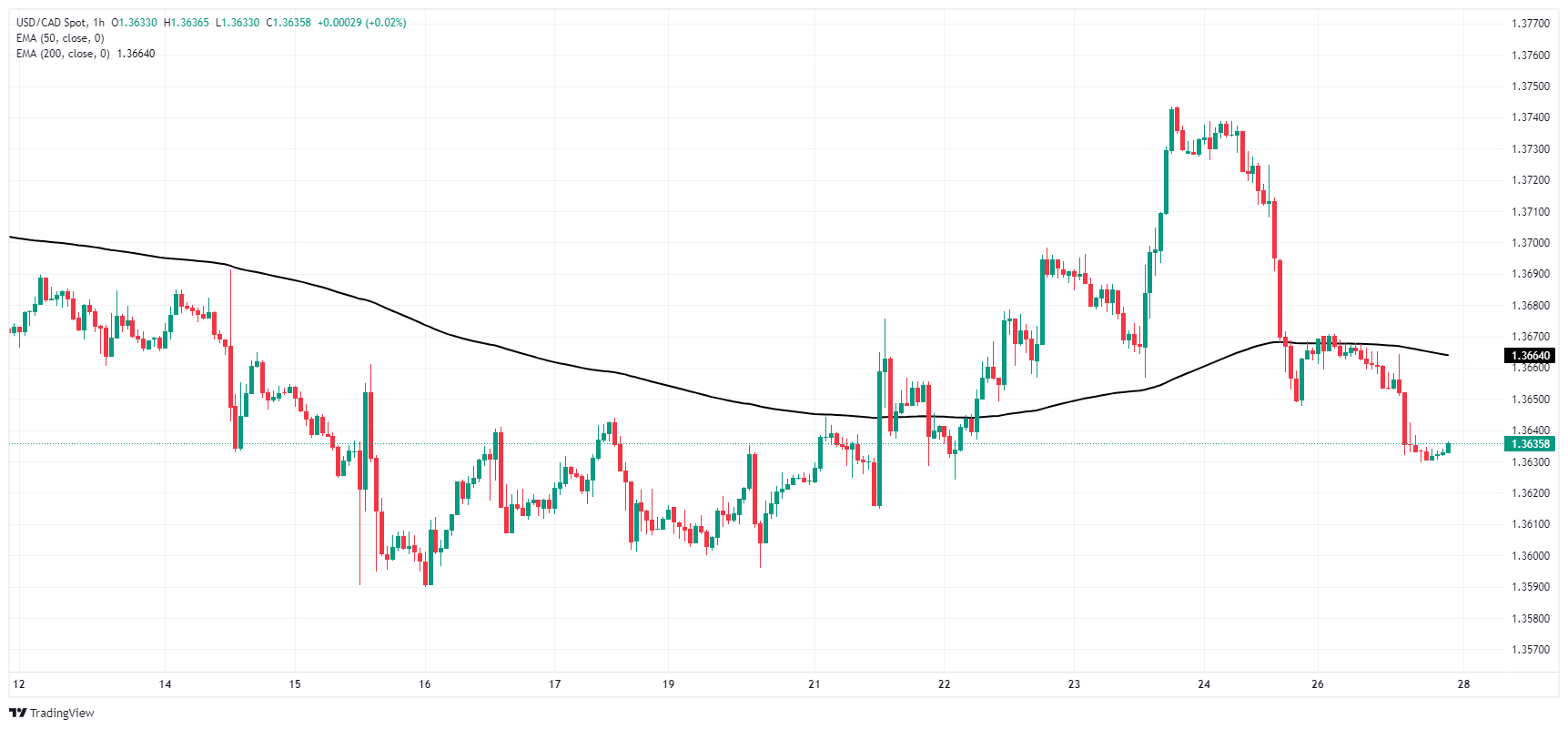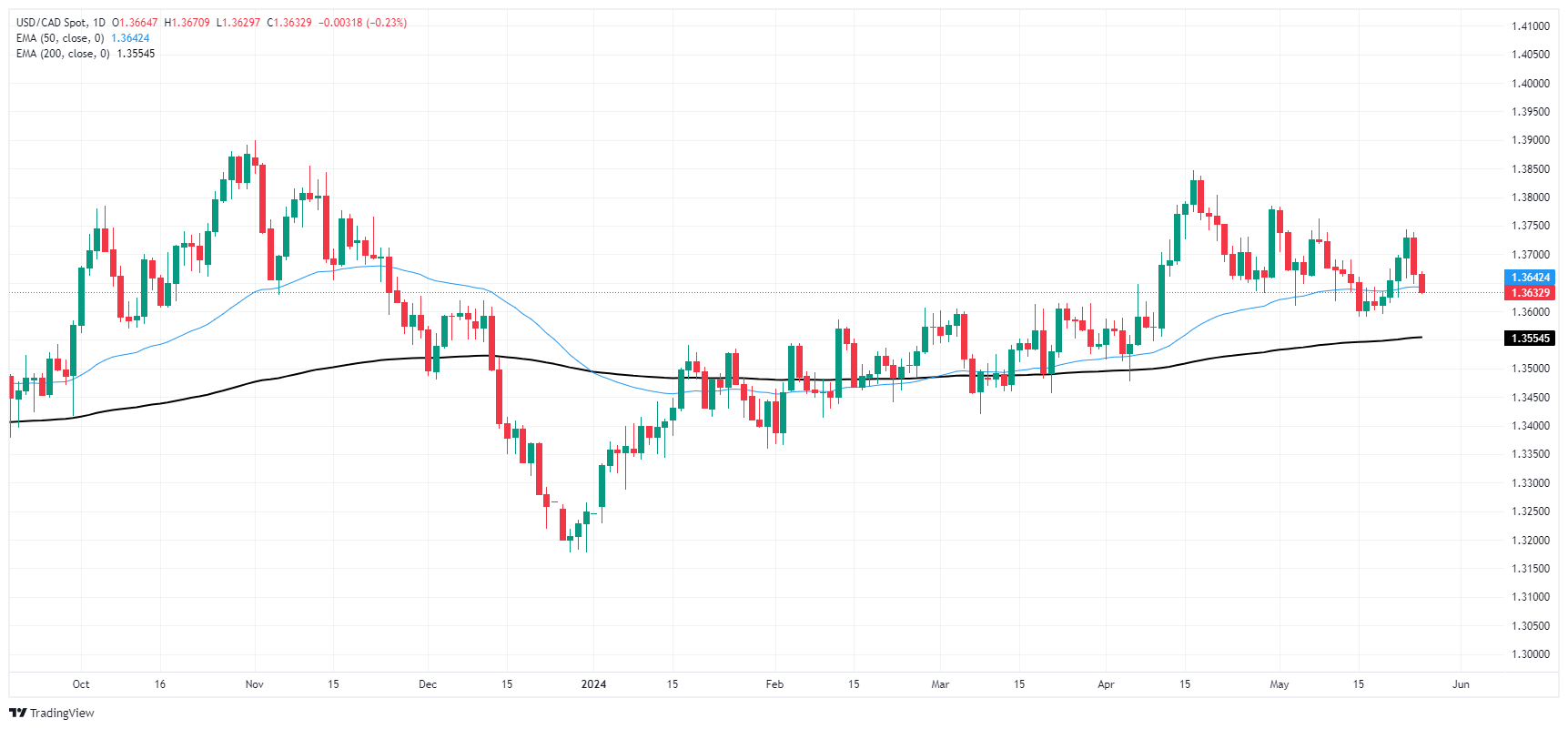Canadian Dollar extends rebound against holiday-weakened Greenback
- Canadian Dollar climbs over Greenback but gives mixed Monday performance.
- Canada brings little of note to the economic calendar until Friday’s GDP release.
- Memorial Day holiday keeps US markets dark, leaves market volumes thin.
The Canadian Dollar (CAD) was mixed on Monday, climbing against the US Dollar (USD) thanks to a quiet US market session. US markets are dark for the Memorial Day holiday, leaving CAD traders to twist in the breeze and await meaningful data prints.
Canada has little of note on the economic calendar early this week, and the release schedule is littered with low-impact figures until Thursday’s Canadian Current Account for the first quarter, which is expected to decline to -5.88 billion versus the previous -1.62 billion. Friday brings a fresh print of Canadian Gross Domestic Product (GDP), which is forecast to ease to a flat 0.0% MoM compared to the previous 0.2%. However, Friday’s Canadian GDP is likely to be overshadowed by key US inflation figures being released at the same time.
Daily digest market movers: Quiet Monday markets give Canadian Dollar a leg up on Greenback weakness
- Canadian Dollar is gaining ground on Monday, due more to fresh weakness in safe haven currencies than any particular CAD-based bidding power.
- According to a StatCan flash estimate, wholesale trade in Canada likely rose 2.8% MoM in April, a welcome sign for investors fearing a potential recession in the Canadian economy.
- Canadian Industrial Product Prices, due to be released on Tuesday, are expected to slow to 0.6% MoM growth from the previous 0.8%.
- Canadian Raw Material Price Index is also expected to recede to 3.2% MoM growth from the previous 4.7%.
- Tuesday will kick off the American trading week with appearances from several key Federal Reserve policymakers as Fedspeak remains a key driver of market flows.
Canadian Dollar PRICE Last 7 days
The table below shows the percentage change of Canadian Dollar (CAD) against listed major currencies last 7 days. Canadian Dollar was the strongest against the Japanese Yen.
| USD | EUR | GBP | JPY | CAD | AUD | NZD | CHF | |
|---|---|---|---|---|---|---|---|---|
| USD | 0.09% | -0.53% | 0.83% | 0.14% | 0.57% | -0.23% | 0.48% | |
| EUR | -0.09% | -0.65% | 0.77% | 0.08% | 0.53% | -0.30% | 0.41% | |
| GBP | 0.53% | 0.65% | 1.28% | 0.73% | 1.19% | 0.35% | 1.06% | |
| JPY | -0.83% | -0.77% | -1.28% | -0.67% | -0.22% | -1.01% | -0.31% | |
| CAD | -0.14% | -0.08% | -0.73% | 0.67% | 0.40% | -0.37% | 0.35% | |
| AUD | -0.57% | -0.53% | -1.19% | 0.22% | -0.40% | -0.83% | -0.12% | |
| NZD | 0.23% | 0.30% | -0.35% | 1.01% | 0.37% | 0.83% | 0.71% | |
| CHF | -0.48% | -0.41% | -1.06% | 0.31% | -0.35% | 0.12% | -0.71% |
The heat map shows percentage changes of major currencies against each other. The base currency is picked from the left column, while the quote currency is picked from the top row. For example, if you pick the Canadian Dollar from the left column and move along the horizontal line to the US Dollar, the percentage change displayed in the box will represent CAD (base)/USD (quote).
Technical analysis: Canadian Dollar steps over softening Greenback
The Canadian Dollar (CAD) is broadly mixed on Monday, gaining around a quarter of a percent against the US Dollar and the Japanese Yen (JPY). However, the CAD is falling back against the Antipodeans, shedding a quarter of a percent against both the Australian Dollar (AUD) and the New Zealand Dollar (NZD).
USD/CAD fell back into familiar congestion on Monday, extending a decline from last week’s late peak near 1.3740. The pair is set to run aground of technical support near the 1.3600 handle, with a long-term floor priced in at the 200-day Exponential Moving Average near 1.3553.
USD/CAD hourly chart
USD/CAD daily chart
Canadian Dollar FAQs
The key factors driving the Canadian Dollar (CAD) are the level of interest rates set by the Bank of Canada (BoC), the price of Oil, Canada’s largest export, the health of its economy, inflation and the Trade Balance, which is the difference between the value of Canada’s exports versus its imports. Other factors include market sentiment – whether investors are taking on more risky assets (risk-on) or seeking safe-havens (risk-off) – with risk-on being CAD-positive. As its largest trading partner, the health of the US economy is also a key factor influencing the Canadian Dollar.
The Bank of Canada (BoC) has a significant influence on the Canadian Dollar by setting the level of interest rates that banks can lend to one another. This influences the level of interest rates for everyone. The main goal of the BoC is to maintain inflation at 1-3% by adjusting interest rates up or down. Relatively higher interest rates tend to be positive for the CAD. The Bank of Canada can also use quantitative easing and tightening to influence credit conditions, with the former CAD-negative and the latter CAD-positive.
The price of Oil is a key factor impacting the value of the Canadian Dollar. Petroleum is Canada’s biggest export, so Oil price tends to have an immediate impact on the CAD value. Generally, if Oil price rises CAD also goes up, as aggregate demand for the currency increases. The opposite is the case if the price of Oil falls. Higher Oil prices also tend to result in a greater likelihood of a positive Trade Balance, which is also supportive of the CAD.
While inflation had always traditionally been thought of as a negative factor for a currency since it lowers the value of money, the opposite has actually been the case in modern times with the relaxation of cross-border capital controls. Higher inflation tends to lead central banks to put up interest rates which attracts more capital inflows from global investors seeking a lucrative place to keep their money. This increases demand for the local currency, which in Canada’s case is the Canadian Dollar.
Macroeconomic data releases gauge the health of the economy and can have an impact on the Canadian Dollar. Indicators such as GDP, Manufacturing and Services PMIs, employment, and consumer sentiment surveys can all influence the direction of the CAD. A strong economy is good for the Canadian Dollar. Not only does it attract more foreign investment but it may encourage the Bank of Canada to put up interest rates, leading to a stronger currency. If economic data is weak, however, the CAD is likely to fall.